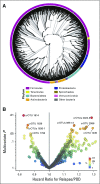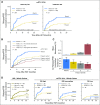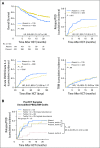Intestinal Microbiota and Relapse After Hematopoietic-Cell Transplantation
- PMID: 28296584
- PMCID: PMC5455763
- DOI: 10.1200/JCO.2016.70.3348
Intestinal Microbiota and Relapse After Hematopoietic-Cell Transplantation
Abstract
Purpose The major causes of mortality after allogeneic hematopoietic-cell transplantation (allo-HCT) are relapse, graft-versus-host disease (GVHD), and infection. We have reported previously that alterations in the intestinal flora are associated with GVHD, bacteremia, and reduced overall survival after allo-HCT. Because intestinal bacteria are potent modulators of systemic immune responses, including antitumor effects, we hypothesized that components of the intestinal flora could be associated with relapse after allo-HCT. Methods The intestinal microbiota of 541 patients admitted for allo-HCT was profiled by means of 16S ribosomal sequencing of prospectively collected stool samples. We examined the relationship between abundance of microbiota species or groups of related species and relapse/progression of disease during 2 years of follow-up time after allo-HCT by using cause-specific proportional hazards in a retrospective discovery-validation cohort study. Results Higher abundance of a bacterial group composed mostly of Eubacterium limosum in the validation set was associated with a decreased risk of relapse/progression of disease (hazard ratio [HR], 0.82 per 10-fold increase in abundance; 95% CI, 0.71 to 0.95; P = .009). When the patients were categorized according to presence or absence of this bacterial group, presence also was associated with less relapse/progression of disease (HR, 0.52; 95% CI, 0.31 to 0.87; P = .01). The 2-year cumulative incidences of relapse/progression among patients with and without this group of bacteria were 19.8% and 33.8%, respectively. These associations remained significant in multivariable models and were strongest among recipients of T-cell-replete allografts. Conclusion We found associations between the abundance of a group of bacteria in the intestinal flora and relapse/progression of disease after allo-HCT. These might serve as potential biomarkers or therapeutic targets to prevent relapse and improve survival after allo-HCT.
Figures




Comment in
-
Relationship Between Intestinal Bacteria and the Anticancer Effect of Hematopoietic Stem-Cell Transplantation.J Clin Oncol. 2017 May 20;35(15):1636-1637. doi: 10.1200/JCO.2017.72.2603. Epub 2017 Mar 15. J Clin Oncol. 2017. PMID: 28296583 No abstract available.
References
-
- Brunet S, Labopin M, Esteve J, et al. Impact of FLT3 internal tandem duplication on the outcome of related and unrelated hematopoietic transplantation for adult acute myeloid leukemia in first remission: A retrospective analysis. J Clin Oncol. 2012;30:735–741. - PubMed
Publication types
MeSH terms
Substances
Grants and funding
- R01 AI101406/AI/NIAID NIH HHS/United States
- R25 CA020449/CA/NCI NIH HHS/United States
- R01 HL069929/HL/NHLBI NIH HHS/United States
- P01 CA023766/CA/NCI NIH HHS/United States
- T32 CA009207/CA/NCI NIH HHS/United States
- R01 HL124112/HL/NHLBI NIH HHS/United States
- R01 AI080455/AI/NIAID NIH HHS/United States
- P30 CA008748/CA/NCI NIH HHS/United States
- KL2 TR001115/TR/NCATS NIH HHS/United States
- R01 AI100288/AI/NIAID NIH HHS/United States
- P30 AG028716/AG/NIA NIH HHS/United States
- UL1 TR000457/TR/NCATS NIH HHS/United States
LinkOut - more resources
Full Text Sources
Other Literature Sources
Medical

